Friday Frivolity no. 2: Orchid Woman Summer
embracing our most orchidaceous selves // jellyfish galore // the beauty of strangeness & the strangeness of beauty
This is the second installment in my new section called Friday Frivolity. This one got a little long, but I hope you enjoy! Essays will resume on Sunday, so keep an eye out.
I also wanted to give a big shoutout to my 5 paid subscribers—it means so so much to me that you support my work! <3
—
Orchid Woman Summer
Before he purchased the three extraordinary slipper orchids, purply-magenta in color, highly saturated, velvety to the touch, as large as a human hand, from an obscure farmer’s stand in Perú, then—miraculously avoiding the scrutiny of the U.S. Department of Agriculture—carried them back in his luggage to the U.S., where the new species (Phragmipedium kovachii) was inspected by a team of orchid experts affiliated with the Selby Botanical Gardens in Sarasota, Florida and promptly declared the most important discovery in the field of orchidology in over a century, setting off a federal investigation, an ousting of Selby Gardens’ executive director, and criminal charges, including the first criminal charges in the US against any botanical garden and 2 years of probation for himself, James Michael Kovach was a carpenter. God, he said, had brought him to orchids.1
“When a man falls in love with orchids, he’ll do anything to possess the one he wants. It’s like chasing a green-eyed woman or taking cocaine,” wrote the orchid hunter Norman MacDonald in 1939.2 A year later, chasing after this most alluring of creatures, this most beautiful of stimulants, he contracted a rare tropical disease in the wilds of Colombia, fell sick of pneumonia, and died. The H. G. Wells story “The Flowering of the Strange Orchid” tells of an unmarried, middle-aged orchid collector who brings home a few rare orchids from a sale, including one that is strange, brown, shriveled up, and frightens the housekeeper. He tends to it in his hothouse, working to revive it. It does indeed revive. Spreading a sickly, overwhelming perfume through the greenhouse, it curls its tendrilling outgrowths around the man and renders him unconscious on the floor, where his housekeeper finds him, rescues him, and must do her best to revive him. Now, there are no orchid species currently known to do this, but looking at certain varieties, who wouldn’t suspect it?
Orchids can be found everywhere on planet Earth except for glaciers. In ancient China, they connoted exceptionality, nobility, and superiority, and it was believed that wearing orchid flowers in one’s hair would fend off evil forest spirits. In ancient Greece, they were a symbol of fertility—“orchid,” after all, comes from the Greek word orkhis, meaning “testicle”—and their roots were used to try to influence an unborn baby’s gender. The Aztecs, crucially for chefs and perfumers the world over, discovered that blessed genus Vanilla, and orchid hunting in the New World brought the strange tropical blooms to Europe, where they reached a fever pitch in the “orchidelirium” of Victorian England. Once a status symbol, they are now to be found in grocery stores across the country and have blossomed into a global market projected to be worth $7 billion by 2027.3 No mere household ornaments, however, they prove themselves useful in medicine and cosmetics, assisting in nervous disorders and fighting that old bugbear of beauty, age.
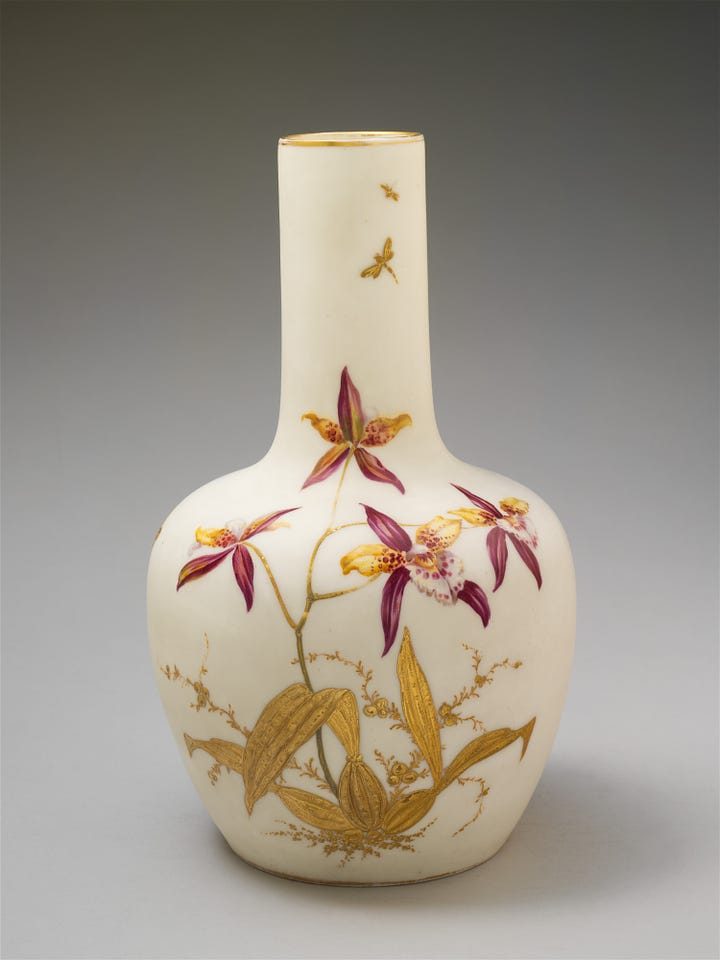
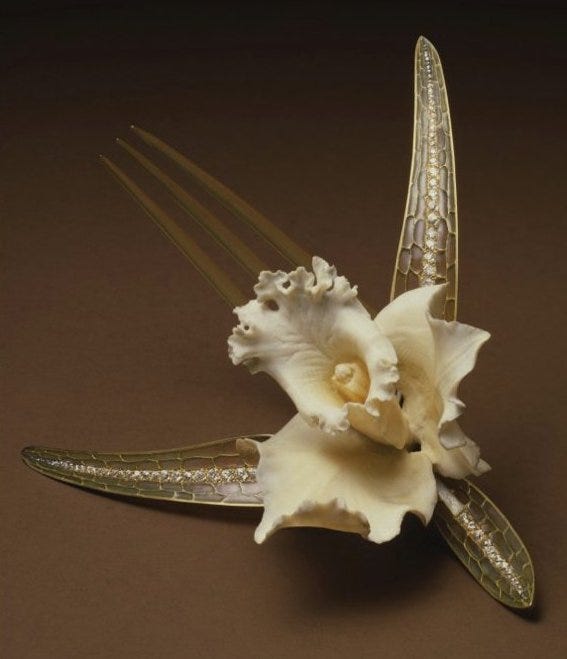
After thousands of years of culture, art, literature, symbolism, after thousands of years of analysis, the linkage of flowers with femininity—what more can be said about it? It has always been, and it always will be, never mind how vexed femininity is in our times. Yet any flower can have soft, delicate petals, a gentle effusion of color, a sweet scent—the orchid is something more. She arrests us in her peculiarity. She is carnal, voluptuous, sensual; she is also strange, alien, sinister. She thrives in a tropical climate, and yet her exoticism is not the exoticism of another country, it is that of another planet. She knows her exceptionality and keeps to a crowd of one: herself. She is not afraid to live life on a larger stage, secure in the certainty that she will never be upstaged in the garden of life, for her colors are bolder, her forms more inventive, her patterning wilder. She inhabits the knife edge where beauty, ripening over, tilts into ugliness, and does not fall over.
Charisma is contradiction. The most compelling people hold several opposite qualities at once: on the surface, they appear to be one way, but in the murky waters below, something struggles, fights, and erupts, working to loosen the sediment of personality. The surface is beautiful, no doubt, but it is what glimmers underneath that urges one to lean forward for a closer look and—with nary a splash—slip in. To seduce means to lead away, and who can lead without luring?

After all this talk of “hot girl summer” and its several spin-offs, I would like to propose that this summer be the Summer of the Orchid Woman. I say “woman,” not “girl,” even if “orchid girl summer” has a better ring, because the orchid could never be anything but womanly. As for the Orchid Woman, she spends her summer in dynamic hues of magenta and mango, in pattern and ornament, in savoring fruit, savoring poems, savoring the sun, savoring herself most of all, in confidence and ardor, in learning, in newness, in experiences and passions.
She has flowered from girlhood to emerge vivid, polychromatic, saturated with a lust for life. Whatever is strange, peculiar, even “ugly” about her, she makes the bedrock of her beauty and the source of her fascination. She exudes exuberance; she has a shimmer on her skin; she reaches for the stars and puts them in her hair. Her “exotic” native soil is the active ferment of her imagination, where her tendrils reach into subterranean depths to cull nutriment from a vast curiosity. Her voluptuousness is never vulgar, for it derives from an authentic avowal of voluptas, “pleasure”—enjoyment without shame, without hurry, without hedging. She demands possession but eludes it, for there is endless variety in her, and she never tires, for her variety is simply a side effect of her force of personality. She inspires hatred in the insecure, fear in the narrow-minded, obsession in everybody. One may love a rose, and love hard, but one would not trek the jungles for it, risk jail for it, devote one’s complete being to it. That belongs only to the orchid.4
Moodboard of the Week
(from left to right, top to bottom)
Diane von Furstenberg Spring/Summer 2016: for this collection, DvF was inspired by a painting of the Roman goddess Fortuna she used to have in her youth, the pre-Raphaelites, and the 1970s, the era she started her career in. Like last week, I’m still in the mood for easy-breezy-floatiness, but this time rendered in lustrous fabrics and vivid colors—mango and fuchsia and bright pink and turquoise and white illuminated with little gold butterflies. The hair and makeup for this collection is pastoral goddess turned 70s disco princess.
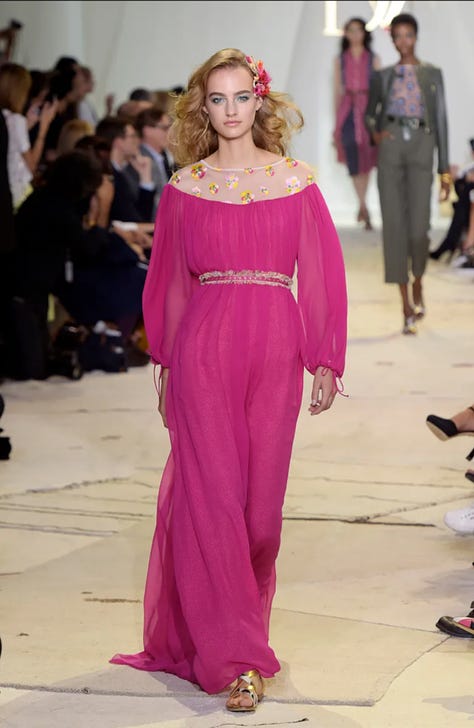
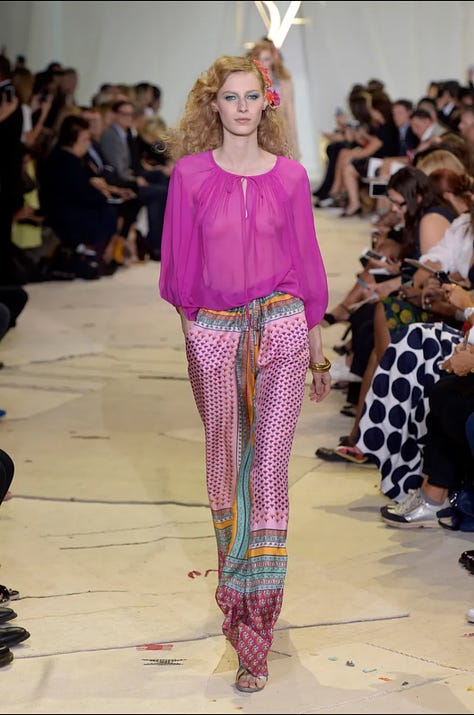
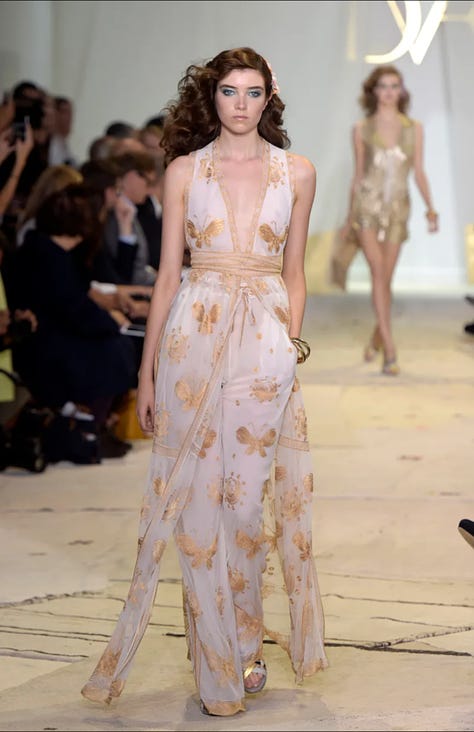

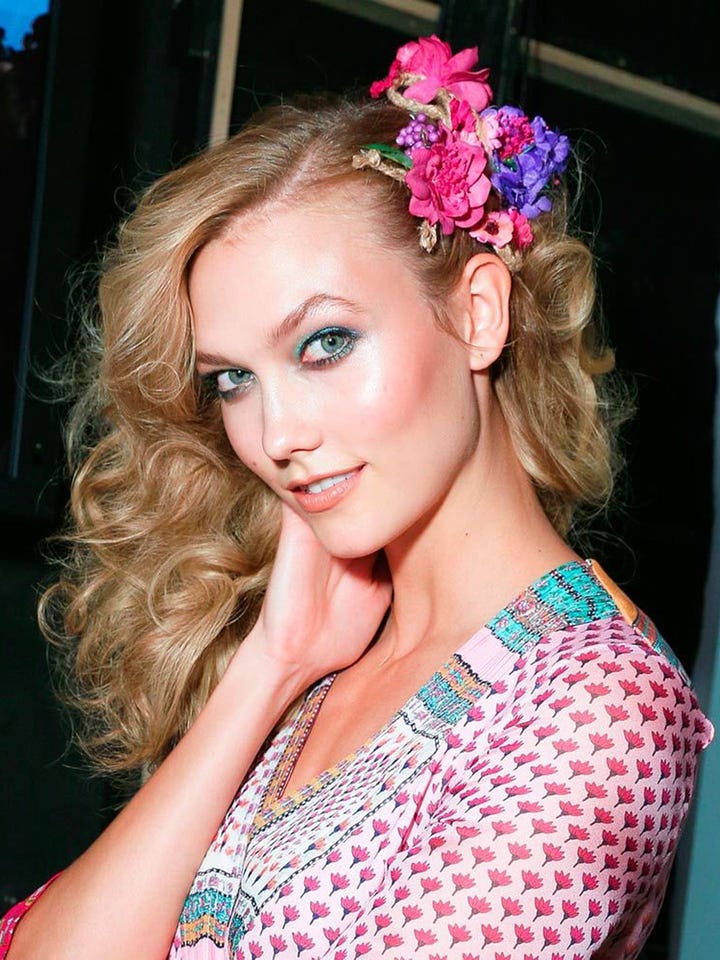
Orchid shoe by Jan Jansen, Spring/Summer 2013: inspired by the species name “Venus’s slipper”—on making these, Jansen said: “Initially I did not dare touch the flower. It was too beautiful, too fragile, too special…. The orchid is erotic, almost organic and voluptuous and it thereby really is the queen of flowers.”
Paul Gauguin, Still Life with Mangoes (1893): from his Tahiti days—Gauguin would paint still lifes while taking a break from figures. The more abstract nature of working without a model allowed him to “concentrate on the ‘musical’ side of his art.”5 There’s a moodiness here—even summer fruits need time off from being bright and cheerful.
Nobuyoshi Araki, Untitled (Orchid). Araki is known for his controversial photographs of women, but I think his pictures of flowers can be equally provocative.
South African singer Tyla on the Swedish talk show The Bianca Show: I came across this after seeing her Met Gala outfit, and I just love the way she carries herself here, how she’s so feminine, bubbly, and confident, how she just puts it out there with zero hesitation that she wants to be “the biggest pop star ever,” and yet it’s not in an arrogant, aggressive, #girlbossy way but in a way that makes you want to root for her—definitely Orchid Woman energy!
Charles Tracy in the book The Color of Fashion (1992): the project of the book involves 12 fashion magazines; they each take over a color and explore it using a variety of models, settings, and outfits. The exuberance of this picture is infectious!
Cy Twombly, Untitled (2001): A year and a half ago, I went to see Anne Carson give a talk about Cy Twombly and the Latin poet Catullus. Twombly’s work includes a lot of references to Greek and Roman literature and mythology, and there’s so much energy in his work: “sheer velocity is what takes place on his canvas,” writes Carson. 6
yasminemei on Instagram: From a series of beautiful arrangements of summer fruits & vegetables—figs, currants, strawberries, raspberries, cucumbers, tomatoes, grapes, peaches, oranges. A follow up from last week’s beauty tip.
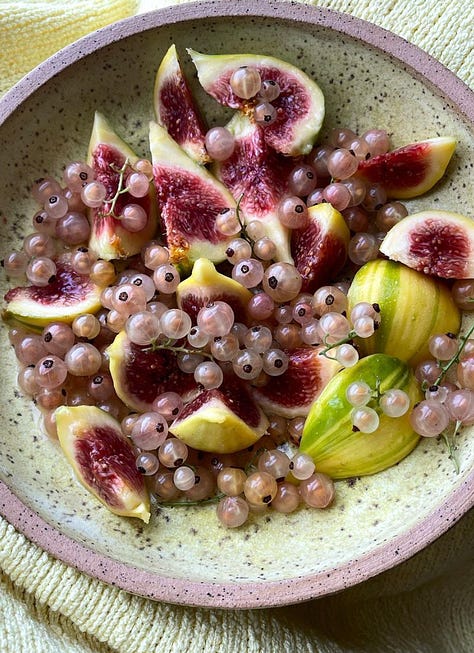
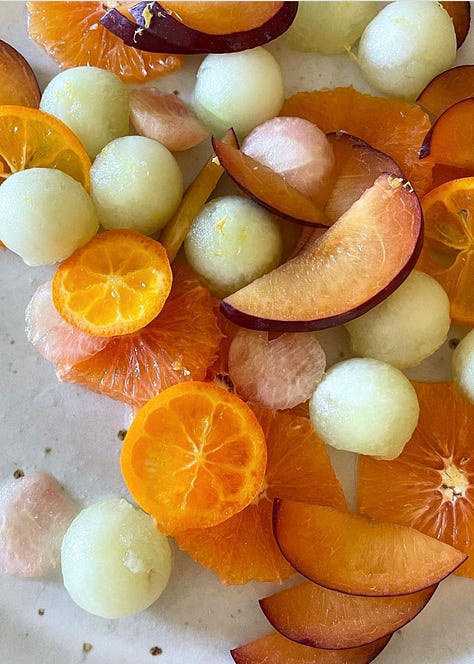
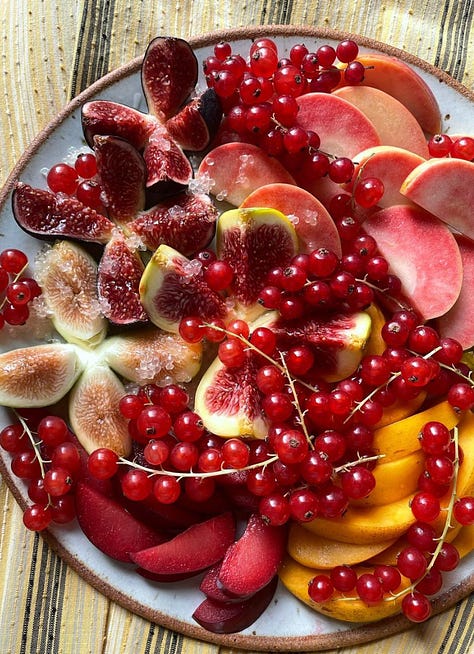
by yasminemei on Instagram Sade performing “Pearls” live in 2011: on TikTok I’ve been seeing this trend of the “Sade girl aesthetic,” where young women try to imitate the elegance, minimalism, and beauty of the singer Sade Abu, with results that are often shallow, milquetoast, and miss the talent and creative power behind that elegance. To be iconic is to be inimitable. An icon may spawn a thousand pale copies, but she always remains immune from them, above, unpolluted. In “Pearls,” Sade sings of a woman in Somalia who, under the sun’s unblinking glare, scours the ground for “pearls”—actually something much more precious: grains of rice for her little girl. This performance moves me because of the perfect combination of the song’s story, the emotion and empathy Sade brings to it in her voice here, and the way the sun shifts and changes behind her. “There is a force stronger than nature / Keeps her will alive.”
3 Things I’m in Love With
This story about the tech startup Antimetal: CEO Matthew Parkhurst spent $15,000 to buy over 1,000 pizzas from local pizzerias in NYC and SF, then sent them off to VC firms, potential clients, and large tech influencers in custom boxes with his company’s branding and contact information on it. About 75% (!!) responded, turning that $15,000 into $1 million in annualized net revenue. Great example of out-of-the-box—or out-of-the-pizzeria-and-into-the-customized-pizza-box—thinking. Although if this becomes a trend, who knows but that VCs & their growing waistlines won’t start looking forward to a cold email again?
This graphic by mudwisard on Tumblr: being able to find the right quadrant for any given situation is such a relief.
Fabric art by Sayuri’s World: I came across Sayuri’s fabric jellyfish online, and then ended up finding these other beautiful sea-inspired fiber works. Textile art is so interesting to me and really makes me wish I didn’t keep procrastinating on learning how to embroider!7
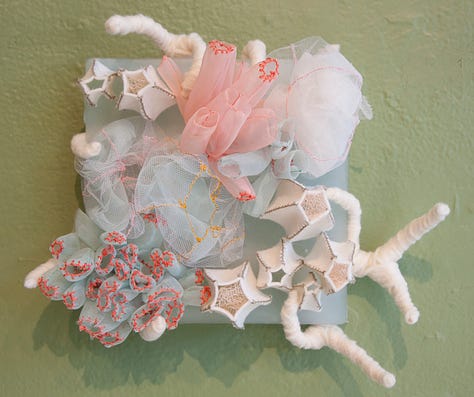

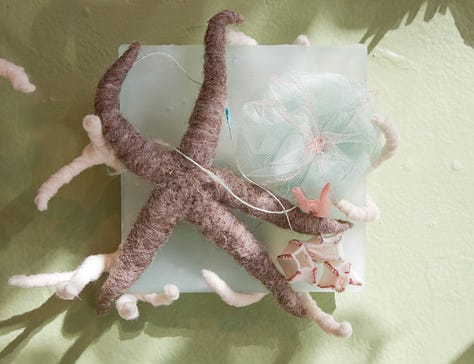
art by Sayuri's World, photos by Joseph Webb
Words of Wisdom
Every life is many days, day after day. We walk through ourselves, meeting robbers, ghosts, giants, old men, young men, wives, widows, brothers-in-love, but always meeting ourselves.
— James Joyce, Ulysses
In honor of Bloomsday last Sunday, I wanted to share a quote from Ulysses, which I’ve been perusing ever since. This comes from Episode 9, “Scylla and Charybdis,” in which Stephen, at the National Library of Ireland, expounds his theory of Shakespeare—really his theory of art and the artist. As an aside, here’s an interesting compilation of Shakespeare allusions in the novel (and probably not all of them)!
Poetry Corner
“Pied Beauty” by Gerard Manley Hopkins
Glory be to God for dappled things— For skies of couple-colour as a brinded cow; For rose-moles all in stipple upon the trout that swim; Fresh-firecoal chestnut-falls; finches’ wings; Landscape plotted and pieced—fold, fallow, and plough; And áll trádes, their gear and tackle and trim. All things counter, original, spare, strange; Whatever is fickle, freckled (who knows how?) With swift, slow; sweet, sour; adazzle, dim; He fathers-forth whose beauty is past change: Praise him.
For celebrating the beauty of the strange—and the strangeness of beauty. This is a form that Hopkins invented, the “curtal” sonnet of ten-and-a-half lines (my love of sonnets will never die), and Hopkins’ use of language is so musical, there’s a way you can almost feel and taste the words in your mouth. The changeable beauty of this earth is “strange,” the beauty of the God who has created it all is “past change”; by praising the former you praise the latter (and vice versa).
Beauty Tip
Often it isn’t that there’s a lack of beauty in our everyday life but that we fail to bring our attention to it. Take a walk and try to notice something you hadn’t before—the shape and patterning of a leaf, the texture of moss, the subtle changes in the light.
Lingering Question
What’s a totally crazy solution to a problem you’d implement if you weren’t too shy or afraid? Dare you to do it!
—
Thank you so much for reading! If you enjoyed, leave a like; if you have an answer to the lingering question or just a thought you’d like to share, drop it in the comments; and if you want to receive these in your inbox every Friday, subscribe to Soul-Making!!
Craig Pittman, The Scent of Scandal: Greed, Betrayal, and the World’s Most Beautiful Orchid (2012).
Norman MacDonald, The Orchid Hunters (1939).
A great read for those who want to learn more about these fascinating flowers is The Orchid in Lore and Legend by Luigi Berliocchi.
https://www.gauguin.org/still-life-with-mangoes.jsp
https://lithub.com/anne-carson-the-sheer-velocity-and-ephemerality-of-cy-twombly/
Video below is Underwater Flight by Sayuri’s World at the Portland International Airport, filmed by Quimby on Vimeo





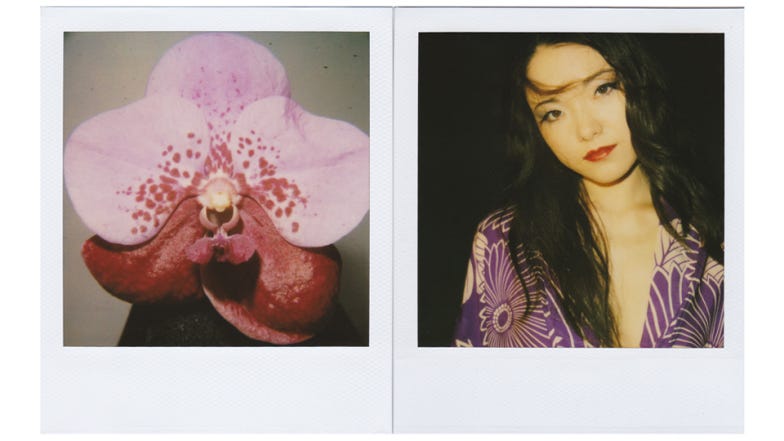
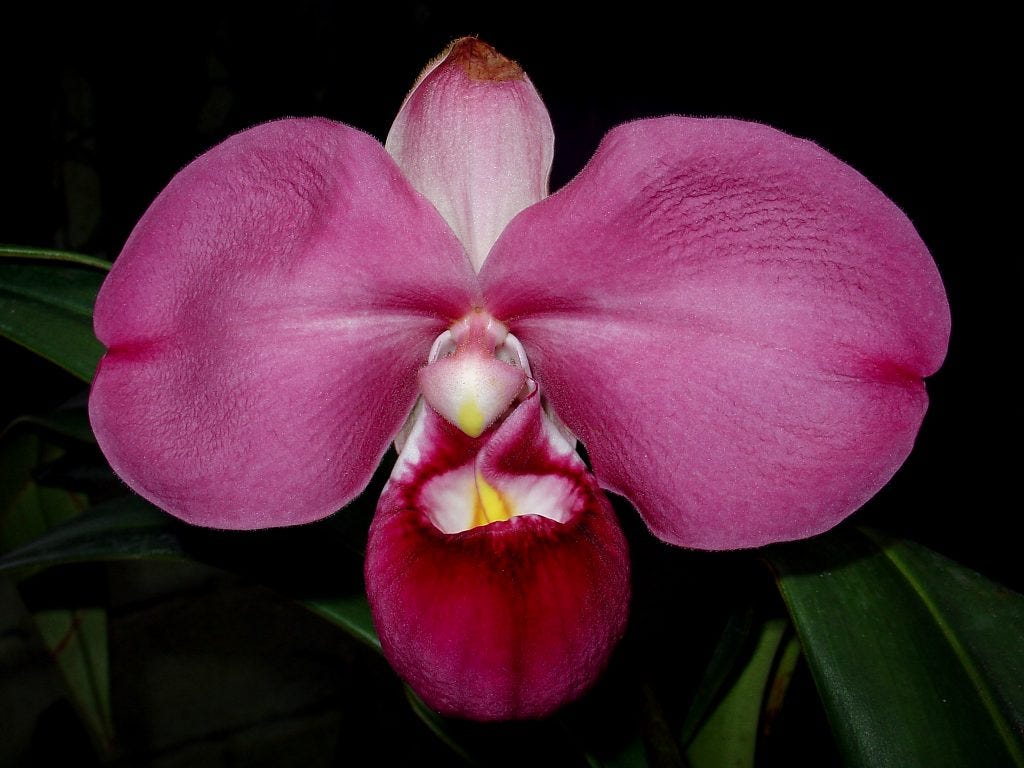
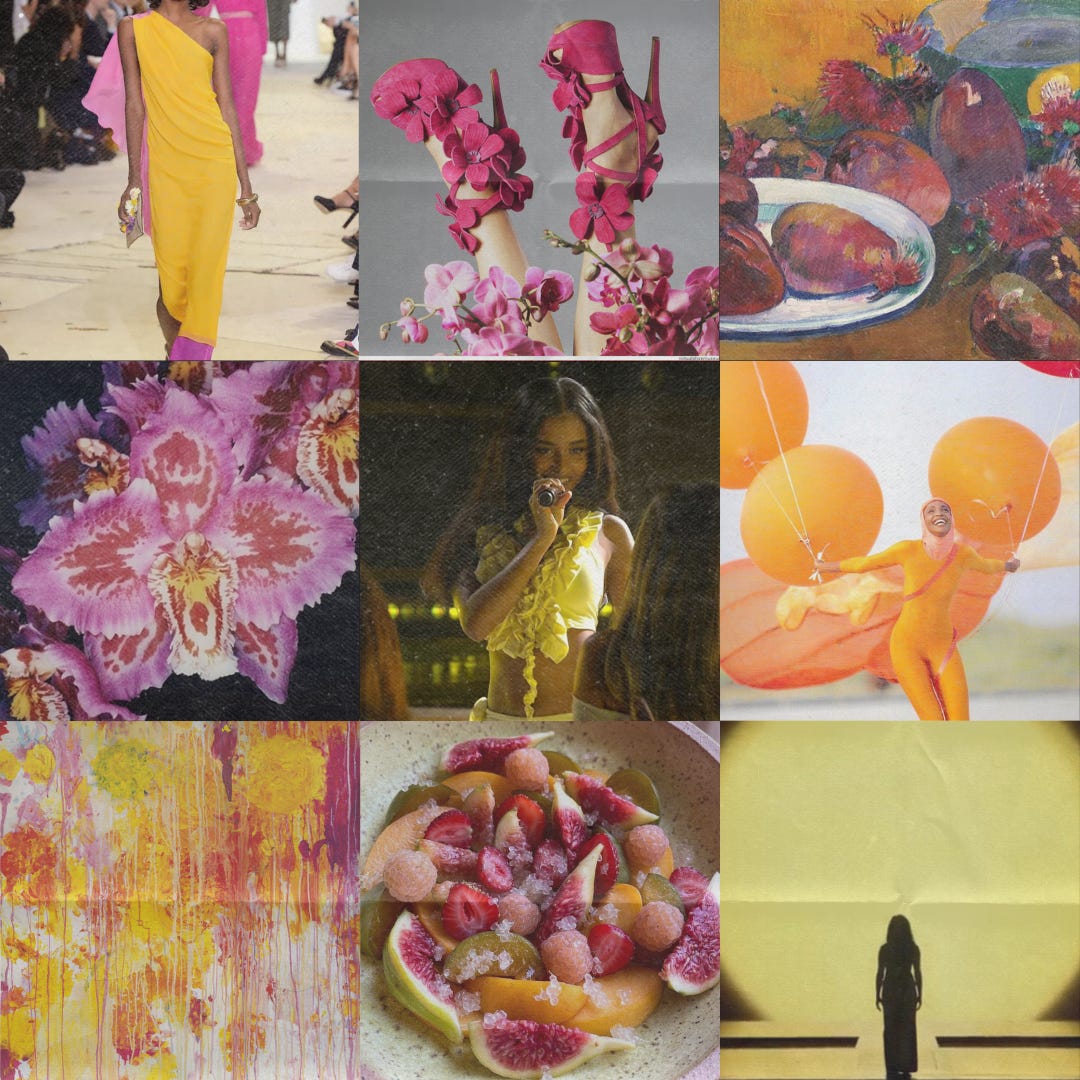

I love this line: “She has flowered from girlhood to emerge vivid, polychromatic, saturated with a lust for life. Whatever is strange, peculiar, even ‘ugly’ about her, she makes the bedrock of her beauty and the source of her fascination.” Sign me up for orchid woman summer!
"Charisma is contradiction. The most compelling people hold several opposite qualities at once: on the surface, they appear to be one way, but in the murky waters below, something struggles, fights, and erupts, working to loosen the sediment of personality. The surface is beautiful, no doubt, but it is what glimmers underneath that urges one to lean forward for a closer look and—with nary a splash—slip in."
Perfectly said Ramya! 👏